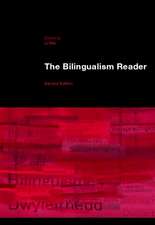Sociolinguistics and the Legal Process
Autor Diana Eadesen Limba Engleză Paperback – apr 2010
Preț: 194.91 lei
Nou
Puncte Express: 292
Preț estimativ în valută:
37.30€ • 38.80$ • 30.79£
37.30€ • 38.80$ • 30.79£
Carte disponibilă
Livrare economică 24 martie-07 aprilie
Livrare express 07-13 martie pentru 35.02 lei
Preluare comenzi: 021 569.72.76
Specificații
ISBN-13: 9781847692535
ISBN-10: 1847692532
Pagini: 320
Dimensiuni: 174 x 245 x 17 mm
Greutate: 0.57 kg
Editura: MULTILINGUAL MATTERS
ISBN-10: 1847692532
Pagini: 320
Dimensiuni: 174 x 245 x 17 mm
Greutate: 0.57 kg
Editura: MULTILINGUAL MATTERS
Cuprins
PART 1 Introduction Chapter 1 Using sociolinguistics to study the legal processPART II COURTROOM HEARINGs Chapter 2 Researching courtroom talk Chapter 3 Focus on trials Chapter 4 Second language speakers and interpreters Chapter 5 Vulnerable witnesses Chapter 6 Courtroom talk and societal power relationsPART III POLICE INTERVIEWs Chapter 7 Police interviews Chapter 8 Police interviews with members of minority groupsPART IV OTHER LEGAL CONTEXTs Chapter 9 Lawyer-client interactions Chapter 10 Informal and alternative legal processes PART V CONCLUSIOn Chapter 11 What (else) can sociolinguistics do?
Recenzii
Not only does Diana Eades' textbook cross disciplinary and cultural borders, but also it bridges the gap between research and pedagogy. Bravo. Bain Butler, University of Maryland in Linguist List 21.3222'Sociolinguistics and the Legal Process' is an ideal text for an introductory course in language and law. Eades's intelligently chosen topics give a full and fair flavor of the field's enormous range. The writing is perfect, crystal-clear without condescension or dumbing-down. Remarkably, Eades succeeds in presenting a theoretically sophisticated account of a sprawling field in a style that can be readily understood by an intelligent undergraduate. John Conley, University of North Carolina School of Law, USAThis is a long-awaited book from one of the leading forensic linguists whose work has had a profound effect on several aspects of the Australian legal system. Diana Eades covers all aspects of interaction within the legal process from the first interview a suspect has with the police, through consultations with lawyers to the complexities of courtroom talk. There is also specific focus on the special problems of child witnesses and those who are not fluent in the language of the court. All readers will find new insights but for students 'Sociolinguistics and the Legal Process' will be invaluable.Malcolm Coulthard, Professor of Forensic Linguistics, Aston University, UK.Because of its textbook orientation, the book contains various exercises, class discussion sections, and assignments for further research interspersed throughout each Chapter, all of which are thought-provoking and carefully integrated into the content of each Chapter. This textbook is a worthwhile and informative Introduction to the sociolinguistic dimension of the legal process.Frank Nuessel, University of Louisville in Language Problems and Language Planning 35:1 2011A highly informative book, Sociolinguistics and the Legal Process is a model textbook in so many ways.Edward Finegan, University of Southern California, USA in The International Journal of Speech, Language and the Law VOL ??.? ???? 319-324Sociolinguistics and the legal process is an especially welcome contribution to the field of language and the law (a field also referred to as forensic linguistics), artfully situating the field within the broader framework of sociolinguistics. Diana Eades brings to this book a wealth of personal research experience in this field, together with an in-depth knowledge of its scholarly literature...Engagingly written, the book is intended to be primarily a textbook for upperdivision undergraduates and graduate students, but it is much more than that. Covering language and law from a multiplicity of theoretical and substantive vantage points, Eades succeeds in producing a textbook that not only explains the field in all of its many facets, but also is thorough and up-to-date in its review of the scholarly works on which it is built.Susan Berk-Seligson, Vanderbilt University in Language in Society 41:1 (2012)

















